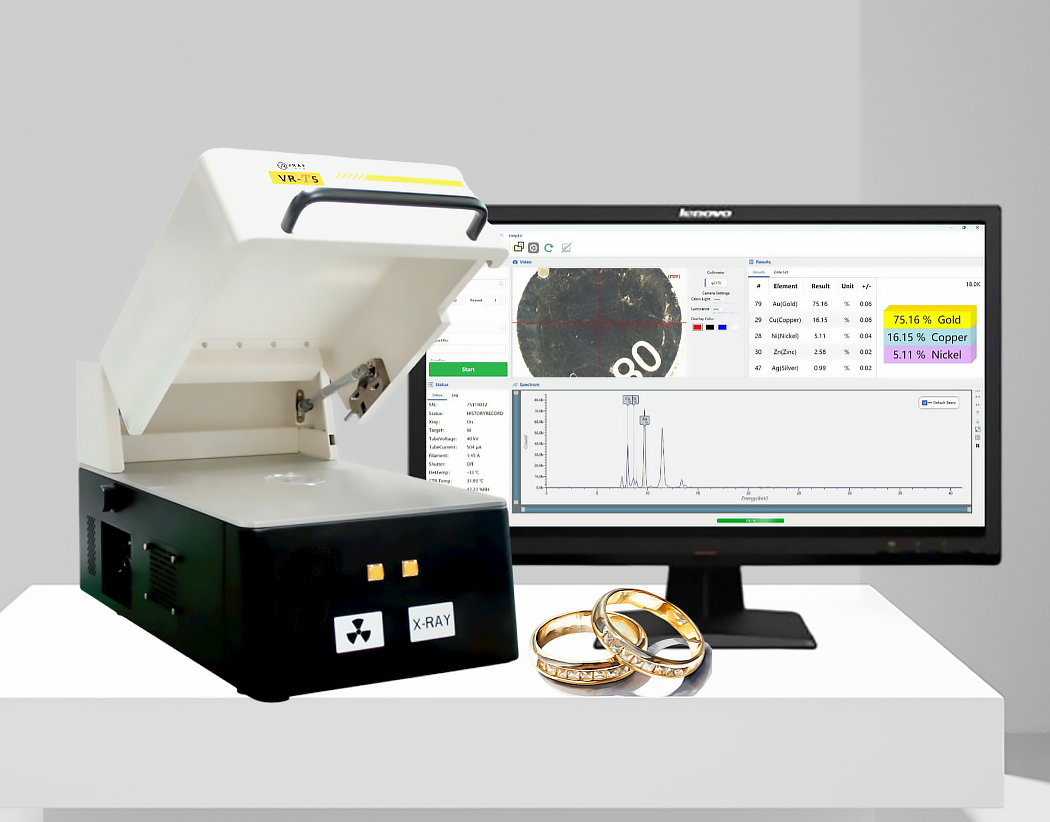Apa peran kolimator di XRF?
In X-ray fluorescence (XRF) spectrometry, a collimator plays a critical role in ensuring accurate and reliable analysis by directing the X-ray beam and minimizing unwanted radiation. It works by narrowing and shaping the beam emitted from the X-ray tube, allowing only the required part of the radiation to reach the sample. This reduces background noise, improves measurement precision, and helps isolate the area being analyzed. Without a collimator, the X-ray beam would scatter, resulting in lower resolution and potential interference from adjacent areas on the sample. In practical applications, especially in industries like jewelry appraisal, emas Daur ulang, and manufacturing quality control, the collimator ensures that even tiny or irregularly shaped samples are measured with precision.

Why Does an Alat Analisis XRF Need a Collimator?
When using an XRF analyzer to test gold, perak, or any other material, the goal is to achieve accurate elemental readings with minimal interference. The collimator acts like a guide for the X-ray beam—it restricts and focuses the path of radiation so it hits only the target sample area. This control:
- Increases measurement precision, especially when working with small samples like jewelry or intricate components.
- Reduces scatter radiation, which otherwise introduces errors in the detected signal.
- Improves repeatability, allowing users to get consistent results even across different testing sessions or operators.
This is especially important in non-destructive testing, where you can’t afford to damage the sample and must rely solely on the clarity of the X-ray spectrum.
How the Collimator Works Inside an XRF Analyzer

In an XRF device, the X-ray tube emits radiation toward the sample. But without guidance, this beam would spread out, losing energy and introducing measurement noise. A collimator is installed between the X-ray source and the sample to channel the beam into a narrow, directed path.
In portable and benchtop models alike, the integration of a collimator enhances the analyzer’s ability to distinguish between closely related elements—like separating gold from platinum or palladium, even when they coexist in alloys.
Collimator and Sample Versatility
One of the major challenges in XRF testing is dealing with different sample types—flat, curved, small, large, or uneven surfaces. The collimator helps solve this by:
- Narrowing the beam to suit small or irregular test zones
- Avoiding edge interference on uneven or layered samples
- Allowing better detection of coatings, pelapis, and layered materials
This is especially valuable when testing recycled jewelry, watch parts, or mixed alloy components where precision is vital and sample surfaces are not uniform.
How VRAY Integrates Collimator Technology
Di Vray Instruments, we prioritize both performance and safety in our XRF analyzers. All our major models—from benchtop units like the VR-T6 dan VR-S6, to portable options like the VR-M5 dan VR-H5—integrate precision-engineered collimators as part of their X-ray guidance and shielding system.
This attention to design ensures:
- Accurate beam focus for testing small and complex sample geometries
- Reduced spectral interference for cleaner and sharper readings
- Improved safety profiles for daily use in retail, lab, and field environments
Our collimator assemblies are manufactured to strict tolerances, ensuring longevity and performance across thousands of test cycles. Whether you’re evaluating the purity of recycled gold, checking silver plating, or analyzing precious metal components in a factory setting, the collimator in a VRAY analyzer guarantees confidence in every result.
Recommended Products from VRAY
If you are testing small jewelry pieces, evaluating coated metals, or conducting detailed precious metal analysis, consider the following VRAY XRF analyzers:
✅ VR-T6 – High-end Benchtop XRF Analyzer
- Down-top beam design with advanced collimation
- Ideal for labs, jewelry manufacturers, and testing centers
✅ VR-H5 – Genggam Penganalisis XRF
- Lightweight with fast results in field testing
- Excellent for mobile gold-buying services and recycling
✅ VR-M5 – Portabel, user-friendly analyzer
- Equipped with lead collimation and Detektor Si-Pin
- Great for point-of-sale testing and material identification
Each of these models leverages collimator technology to ensure akurat, pengujian non-destruktif dan maximum safety, making them ideal for any application that demands precision and reliability.
Pikiran terakhir
A collimator might seem like a small part of an XRF analyzer, but its role is foundational. It shapes the X-ray beam, eliminates background noise, enhances accuracy, and protects users—all at once. In competitive industries like precious metal appraisal, manufaktur, and quality inspection, these advantages translate to better decision-making and stronger business results.
Choosing an analyzer that integrates a well-designed collimator is not just a technical preference—it’s a strategic decision.
Pertanyaan yang sering diajukan
Q1:Can I test small or curved jewelry pieces with an XRF analyzer?
A1:Ya. The collimator narrows the beam, allowing for accurate readings on small, curved, or irregular surfaces without interference from adjacent areas.
Q2:Does the collimator affect the lifespan of an XRF device?
A2:Tidak. On the contrary, a high-quality collimator improves the instrument’s reliability by reducing scatter and extending the performance consistency over time.
Q3:Is it safe to use XRF analyzers frequently?
A3:Ya. Analisis XRF modern, like those from VRAY, use built-in collimators and shielding to limit radiation exposure, meeting safety regulations for daily use.
Q4:How do I know if my analyzer uses a collimator?
A4:Most professional-grade analyzers—especially from trusted brands like VRAY—include collimators by default. Check your product specs or consult our team for confirmation.

WhatsApp
Pindai Kode QR untuk memulai obrolan WhatsApp dengan kami.